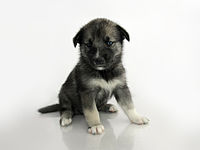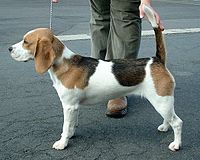 Image via Wikipedia
Image via Wikipedia
One of the most common causes of newborn puppy deaths is what has been named as the "fading puppy syndrome." Many of the unexplained puppy deaths that fall into this category would undoubtedly go elsewhere if only an accurate diagnosis could be made. Unfortunately, many of these poor little pets die so rapidly that no diagnosis can be made.
The fact is that whether or not the fading puppy syndrome is actually a distinct disease is still questionable. Many believe that it is what happens to any puppy that is unprepared, for whatever the reason, to face the stress of living in the world outside of his mother's womb. Whether or not the failure in preparation occurs before or after the pup is born depends on the reason for the puppy's fading,
Successfully saving the fading puppy that can be saved depends on recognizing the condition early enough and implementing proper remedial action. As a dog owner, you have to be very perceptive in order to recognize early enough the signs of a potential syndrome puppy. Below are some of the things to look out for:
1. An absence of the flight reaction: When normal puppies are taken from their mother and released, they will usually make every effort to scurry back to her. On the other hand, the syndrome puppy will not attempt to go anywhere.
2. Abandonment by the mother: A healthy, normal puppy is licked and protected by his mother. The syndrome puppy is left out of the litter and left in the corner to die.
3. "Slow-motion" activity: A healthy, normal pup is always busy and does not move slowly to do anything while a fading puppy makes slow, deliberate movements, almost like in a slow-motion picture.
4. Hypothermia: Most puppies can survive considerable hypothermia, and normal puppies in a litter usually feel warm and have ample supply of energy to keep their bodies from getting cold. The syndrome puppy does not like to eat and feels cold to the touch.
When you have recognized a puppy that is in the early stages of the fading puppy syndrome, you need to take him away from his mother and littermates and handle him just as if he were an orphan. In order for him to survive, you will have to raise him and feed him yourself by means of either bottle or stomach tube.
![Reblog this post [with Zemanta]](http://img.zemanta.com/reblog_e.png?x-id=8396ed50-25e0-4386-b344-040913850d20)

![Reblog this post [with Zemanta]](http://img.zemanta.com/reblog_e.png?x-id=d5171866-64a2-4cee-857c-cae52e394397)

![Reblog this post [with Zemanta]](http://img.zemanta.com/reblog_e.png?x-id=b66dc6b4-7ba1-48f8-8188-8844e8109cad)

![Reblog this post [with Zemanta]](http://img.zemanta.com/reblog_e.png?x-id=12f28934-eeb6-452d-ae55-5242a4ba270e)

![Reblog this post [with Zemanta]](http://img.zemanta.com/reblog_e.png?x-id=1e560ed8-9998-42b7-98dc-50eb05ceed14)

![Reblog this post [with Zemanta]](http://img.zemanta.com/reblog_e.png?x-id=e33ec3c2-8f9e-48b8-a1b3-65ff2ecd382b)
![Reblog this post [with Zemanta]](http://img.zemanta.com/reblog_e.png?x-id=9f432b5f-fd4b-4520-af61-8f88f4c92a11)